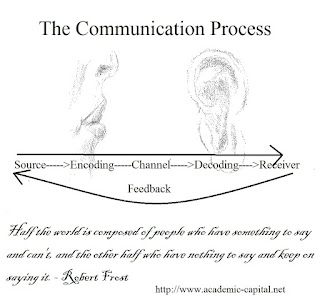Paralanguage is related
to the use of subtle messages that includes tone, prosody, intonation, tempo, syllable
emphasis, and other hints that create additional meaning beyond the words
themselves. Knowing and understanding how paralanguage influences clarity can
help in creating more effective conversation in the workplace. Managers who are
capable of creating higher levels of congruency between the words they use and
the paralanguage associated with those words can increase their communication
effectiveness and organizational influence.
Most information comes
from non-verbal aspects of communication and alignment between these two
concepts creates congruence. A study of university lecturers helped identify
that those who used appropriate pitch, loudness, variability, pauses, and
fluency increased audience satisfaction (Md Zani, et. al, 2011). The audience
paid more attention and were more focused on the concepts. This helps ensure
that the messages not only came across well but were also received by members
of the audience.
If the use of
paralanguage can benefit the quality of communication in a public forum it can
also benefit management and employee relationships. As employees seek to
understand expectations, directions, and practical information they will listen
beyond the words into paralanguage to determine both intent and hidden meaning.
This intent, whether positive or negative, will help ensure the truthfulness of
the message.
In many cases employees
are not consciously aware of these messages and intuitively prescribe them to
the words being spoken. The use of paralanguage is a system that develops within
a cultural heritage to further expand the language capabilities between members
(Wang De-hue, 2007). Because we are raised within a particular culture we may
have some difficulty interpreting the meaning of messages from other cultures. The
more we associate with other cultures the more able we are to understand their
subtle messages.
We begin to become
aware of that language at a young age in the same way that we become aware of
social context. At the age of six children are still more likely to judge the
actual words versus the subtle differences in paralanguage (Morton & Trehub
2001). Yet by the time they become adults they are much more astute at this
overall judgment between spoken language and its subtle paralanguage.
To create congruence of
language also creates clarity in the message as well as its perceived honesty.
For many managers it is about being aware of such language and its potential
impact on employees that will help them create stronger relationships with
employees as well as more effectiveness within their management style. It is
through continuous practice that managers can improve both the giving as well
as the reception of such messages.
Organizations should
consider a level of training in language usage as it pertains to the workplace.
A number of studies have indicated that both written and verbal communication
skills are important factors of success in the workplace. Employee resistance,
misinterpretation, wasted employee effort, conflict, and general labor
relations are all associated with the proper use of language. The concept
becomes even more important as leaders grow in influence and power. It is
difficult for them to clearly articulate their strategic visions if they are inadvertently
giving off mixed signals that are interpreted differently by different sectors
of society.
Md Zani, et. al.
(2011). The relationship between lecturers’ paralanguage and student’s
satisfaction in Universiti Teknologi Mara, Kendah, Malaysia. Interdisciplinary Journal of Contemporary
Research in business, 3 (6).
Morton & Trehub, S.
(2001). Children’s understanding of emotion in speech. Child Development, 72 (3).
Wang, D. & Li, H.
(2007). Nonverbal language in cross-cultural communication. US-China Foreign Language, 5 (10).

